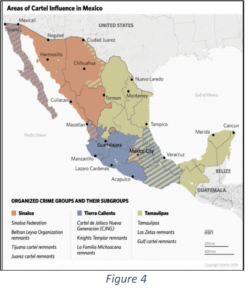
On March 10, 2020, at approximately 4:40 pm local time, Cèsar Valencia Caballero, the mayor of Aguililla, Michoacan, Mexico, was found dead. According to reports by the Agence France-Presse, a French-based international news agency, the man had been shot at least twice in the chest and neck.
This killing came just three weeks after the mayor, previously a local rancher and farmer, had allegedly declared an end to the cartel wars in the area. This announcement had been prompted by action taken by the federal police and military of Mexico to “free” the city after months under the control of the Cártel de Jalisco Nueva Generación (CJNG), also known as the Jalisco Cartel.
For this Overwatch, analysts will leverage publicly available data from various sources to statistically answer the question: what is driving the assassination of mayoral politicians by cartels in Mexico?
Mayor Caballero’s death is just the most recent in a long line of mayoral assassinations, as seen in Figures 1 and 2, created using data from The Justice in Mexico Project. According to the Justice in Mexico Project 2021 Special Report, a mayoral figure, defined as a mayor, candidate, or former mayor, was four times more likely than the average citizen to be killed in Mexico in 2020, as opposed to 13 times more likely, which was the statistic the year prior in 2019.


By looking at the context in which Caballero’s assassination took place, we can begin to pull out salient factors that might affect the assassination of mayoral politicians throughout all of Mexico.
The city of Aguililla was one of many in the region that have served as the focal points of a battle between Carteles Unidos (CU) and CJNG. The fighting between these groups has seen the State of Michoacan become the state with the fifth-highest homicide rate (59.3/100,000) in the country from June 2021 to May 2022. This was an increase of approximately 8.7/100,000 compared to one year ago.
Unlike the CJNG, which resembles a more traditional cartel, the CU started as a loose affiliation of cartels and gangs native to the Michoacan who had once come together in 2010 to fight off the encroachment of the Los Zetas cartel. As the original cartels of the region began to fall from power, what replaced them was a series of localized gangs, coalitions of smaller cartels, and self-defense forces. Most of these armed groups are made from the remnants of those former groups and often fight amongst each other or against external threats to seize control of the territory they inhabited.
This fragmentation process, the process through which large national cartels are reduced to smaller localized regional cartels and criminal cells, is not only underway in the state of Michoacan. A look at the series of maps (Figures 3, 4, and 5) shows an increasingly fragmented cartel landscape. According to the International Crisis Group, there were roughly 205 in 2020, a sharp increase from the 76 present in 2010.



As a result of this fragmentation, criminal actors, necessity, and a desire for profit have increasingly turned their sights inward to domestic sources of profit. As early as 2014, it was reported that the Zeta and the Knights Templar cartels were no longer making most of their earnings through drug trafficking but through iron ore. However, diversified illicit profit streams extend outside the extortion of mining companies and illegal mining operations. They include the extortion of avocado farmers, the extortion of local businesses, oil and gas theft, endangered wildlife trafficking, kidnapping, and smuggling.
The prevalence of these forms of extortion and looting of the local population by criminal actors in Mexico can be seen in the worries of the residents of Aguililla. After the end of their occupation by the CJNG, they are not celebrating. They are described as being worried about possible reprisal killings and the continuation of the CU “War Tax,” an extortion method in which the CU targets lucrative agricultural resources grown in and exported out of the area, such as avocados, limes, and mineral wealth.
The overall fate of the town of Aguililla and the region remains to be seen. Still, from the events described, we begin to get a picture of an evolving landscape of cartel violence in Mexico, especially compared to the 2006-2014 period of the conflict. Two key features mark this ongoing situation. First, the number and type of actors in this conflict have shifted, and second, the revenue streams these actors draw from have diversified. These and some control variables will be the main characteristics tested in the model below to understand local political violence.
To understand what factors are significantly contributing to this type of violence, Overwatch will use a method of quantitative analysis. This information places environmental factors derived from open-source state-level data[1], such as cartel fragmentation, political pluralization, the killing or arrest of cartel leaders, mining output, avocado output, and the number of illegal pipeline taps against the event of a mayoral assassination, allowing us to see what factors are statistically significant in predicting incidents of mayoral assassination in a State. The model will control for several factors, including election years, the number of municipalities in a state, the homicide rate of a state, the estimated population of a state, the end of Mexico’s gas subsidy, and the Human Development Index (HDI), an aggregated measure of prosperity in the area. The model will be run twice, first from the time of 2006-2019 and then from the period of 2012-2019, to consider the roles that fuel theft is playing when it comes to mayoral assassinations.
[1] Sources used for the quantitative models
Mayoral Assassinations: Justice in Mexico Project Memoria Dataset. Supplemented through advanced queries for missed assassination events.
Cartel Fragmentation, Political Pluralization, Arrest/Death of Cartel Leaders 2006-2015: Laura Blume’s academic article The Old Rules No Longer Apply: Explaining Narco-Assassinations of Mexican Politicians – Laura Ross Blume, 2017 (sagepub.com)
Cartel Fragmentation, Political Pluralization, Arrest/Death of Cartel Leaders 2016-2019: supplemented through open-source research queries.
Mining Output: The Mexican Geology Service
Illegal Pipeline Taps: IGAVIM (NGO charting fuel theft in Mexico)
Avocado Output: Secretary of Agriculture and Rural Development
Number of Municipalities, Estimated Population, Violent Homicide Rate: National Institute of Statistics
Human Development Index: Global Data Lab
| Model 1 (2006-2019) | Model 2 (2012-2019) | |||
| Dependent: Mayoral Assassinations | ZINB | ZIP | ZINB | ZIP |
| Avocado Production Value (100,000s of pesos) | 3.25e-06***
(8.24e-07) |
3.10e-06***
(7.65e-07) |
3.09e-06*** (9.66e-07) | 3.09e-06***
(9.66e-07) |
| Designated Red Triangle Area | .3440403 (.293146) | .3776276 (.3067098) | .1315405 (.2806082) | .131554
(.2806048) |
| Number of Illegal Pipeline Taps Detected | .0004163** (.00014) | .0004163** (.00014) | ||
| Total Value of Mined Lootable Resources (100,000s of pesos) | -3.34e-07 (8.46e-07) | -3.18e-07 (8.39e-07) | 6.49e-07 (8.54e-07) | 6.49e-07
(8.55e-07) |
| Gas Shock | 1.644253* (.6910199) | 1.711019* (.6824836) | .5952097 (.3603463) | .595184
(.360356) |
| Total Cartels | .1492155 (.0783382) | .1459798 (.0777265) | .0086074 (.0920103) | .0085645
(.0920157) |
| Kingpin | .1536357 (.2005211) | .122137 (.199723) | -.0923125 (.1881991) | -.0923967
(.1882025) |
| Lagged Political Pluralization | 1.172203 (.9245133) | 1.1806 (.9493756) | .6671332 (.9917837) | .6671474
(.9918213) |
| Human Development Index | -8.823877** (3.138733) | -9.3168***
(3.331301) |
-16.481*** (3.742241) | -16.4833***
(3.742202) |
| Homicides/100,000 people | .0173533*** (.002475) | .0170105*** (.0022406) | .0158983** (.0048266) | .0158989***
(.0048268) |
| Population Estimates | 1.03e-07*** (1.78e-08) | 1.01e-07***
(1.66e-08) |
9.74e-08*** (2.08e-08) | 9.75e-08***
(2.08e-08) |
| Number of Municipalities | .0032946*** (.0005619) | .0031435*** (.000582) | .0025737*** (.0005316) | .0025733***
(.0005316) |
| Inflated Total Cartels | -1.014295* (.4326191) | -.3714208 (.873021) | -1.631413** (.5462995) | -.8482871*
(.4216407) |
| # of observations (N) | 434 | 434 | 248 | 248 |
| Wald chi^2 | 302.97 *** | 304.31 *** | 277.79 *** | 277.79 *** |
Standard errors in parenthesis, p-value *=.05 **=.01 ***=.001
After running these models, it was determined that for every unit, 100,000-peso (~$5,000), increase in estimated value from avocado farming, there is an expected increase in the mayoral assassinations rate of .000003, all else being equal. Additionally, for every additional illegal tap detected, we expect the number of mayoral assassinations in a region to be a .000416 increase in mayoral assassinations. Though these numbers may seem insignificant, they have a statistically significant effect, meaning that when predicting incidents of mayoral assassinations, these two variables are better indicators than factors that focus on the fragmentation of cartels.
Notably, the control variable HDI is also significant, meaning states with lower HDI scores are more likely to suffer from mayoral assassinations. This is possibly because fragmented criminal groups cannot easily target affluent and well-secured regions in Mexico and prefer to prey on lower socio-economic areas.
In both models, factors such as the extradition or death of a cartel boss, the number of cartels in an area, and political polarization were insignificant, meaning they do not act as statistical predictors of mayoral assassinations. The insignificance of these three variables could be due to the changing environment in Mexico. As seen in Figure 6 above, most states house multiple armed groups. At the same time, the process of leadership decapitation that started in 2006 has turned the criminal landscape into several independent cells and loose affiliations that are becoming more immune to the arrest of leaders. These two factors, present throughout most of Mexico in the last few years, do not go nearly as far in predicting mayoral assassinations as a state’s natural resource wealth.

Overall, what this model shows is that a mayoral politician of a town experiencing inter- or intra-cartel conflict but whose municipality is not rich in lootable natural resources, or sources of extortion, is in a relatively safer position than a mayoral politician suffering from the same predicament, but also finding themselves in charge of an area with high amounts of lootable natural resource wealth and points of extortion. In addition, it reveals that the assassination of these mayors is concentrated in states that rank lower in terms of socio-economic status. In other words, the criminal and socio-economic environment may lead to initial vulnerabilities, but the economic incentives provide the drivers for political violence.
Our Assessment:
Using the above findings, Overwatch analysts assess that if trends in criminal fragmentation and diversification of illicit revenue streams continue, there will be a surge in political violence in Mexico starting in late 2023 and culminating around Mexico’s 2024 election. This would follow trends seen during the 2018 and 2021 election seasons. If the above model is correct, political violence in 2024 will likely concentrate in states and municipalities that are rich in lootable natural resources and targets for extortion. In addition, political violence will likely concentrate lower socio-economic areas surrounding the 2024 election.
Additionally, Overwatch analysts assess that much of business surrounding local resources in Mexico will continue to involve cartels and criminal actors moving forward, likely leading to the fluctuation in prices of key natural resource markets and previously agreed upon business contracts.
These problems will likely be exacerbated as the Mexican government attempts to “decapitate” the Jalisco Cartel or other large cartels still operating in Mexico. This will probably increase the violence aimed at local citizens and politicians, as groups like the CU disintegrate without an external enemy to fight against. In addition, splinter cells of the now headless cartels turn towards their local economies and surrounding territories to supplement their affected revenue streams.

